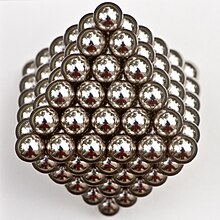Octahedral number

An octahedral number is a number that is based on the formula
can be calculated from a natural number . The first octahedron numbers are
For some authors, the zero is not an octahedron, so the sequence of numbers only begins with the one.
The name octahedron is derived from a geometric property. If you put balls into an octahedron by laying squares on top of each other, the side lengths of which increase by one from top to bottom and decrease by one after reaching the edge length , then the number of balls corresponds to one octahedron number. Here, the number of squares with an edge length of one- and hence the number of balls that form an edge of the octahedron. Because of this relationship with a geometric figure , the octahedron numbers belong to the figured numbers , which also include the triangular numbers , square numbers and tetrahedral numbers .
Relationships to other figured numbers
Square pyramidal numbers
An octahedron, which is made up of spheres as described above, can be divided into two pyramids with a square base, with a pyramid with the edge length lying upside down under a pyramid with the edge length . Therefore the -th octahedron number is the sum of two consecutive quadratic pyramidal numbers :
- .
Tetrahedral numbers
If the th Oktaederzahl and the th tetrahedral number is, then
- .
This relationship can be represented geometrically as follows: If an octahedron of the edge length is "glued" on each of the four sides that are not adjacent to each other, a tetrahedron of the edge length results .
Another relation results from the fact that an octahedron can be broken down into four (distorted) tetrahedra, each of which butt on two surfaces:
- .
This division can also be represented in such a way that the octahedron is first divided into two pyramids with a square base with the edge lengths and , as described above , and then each of these pyramids is in turn divided into two (distorted) tetrahedra: The pyramid with the edge length is converted into tetrahedron with the edge lengths and divided, the pyramid with the edge length is divided into tetrahedra with the edge lengths and .
Cube numbers
If two tetrahedra with the edge length are "glued" to opposite sides of an octahedron with the edge length , the result is a rhombohedron . A rhombohedron can be thought of as a distorted cube, so the number of balls in such a rhombohedron is a cube number and it applies
- .
Centered square numbers

The difference between two consecutive octahedron numbers is a centered square number :
- .
An octahedral number is also the number of spheres in a pyramid of centered squares; therefore, in his book Arithmeticorum libri duo (1575) , Francesco Maurolico called these numbers “pyramides quadratae secundae”.
The number of spheres in an octahedron of centered squares is a centered octahedron number . It is the sum of two consecutive octahedral numbers and can be calculated using the formula
to calculate. These are the first numbers of this series
Generating function
The function
contains in its series expansion (right side of the equation) the -th octahedron number as a coefficient to . It is therefore called the generating function of the octahedron number.
Web links
- Eric W. Weisstein : Octahedral Number . In: MathWorld (English).
Individual evidence
- ^ A b c John Horton Conway , Richard Kenneth Guy : The Book of Numbers . Springer-Verlag, 1996, ISBN 0-387-97993-X , p. 50 (English).
- ↑ John G. Burke: Origins of the science of crystals . University of California Press, 1966, pp. 88 (English, google.com ).














